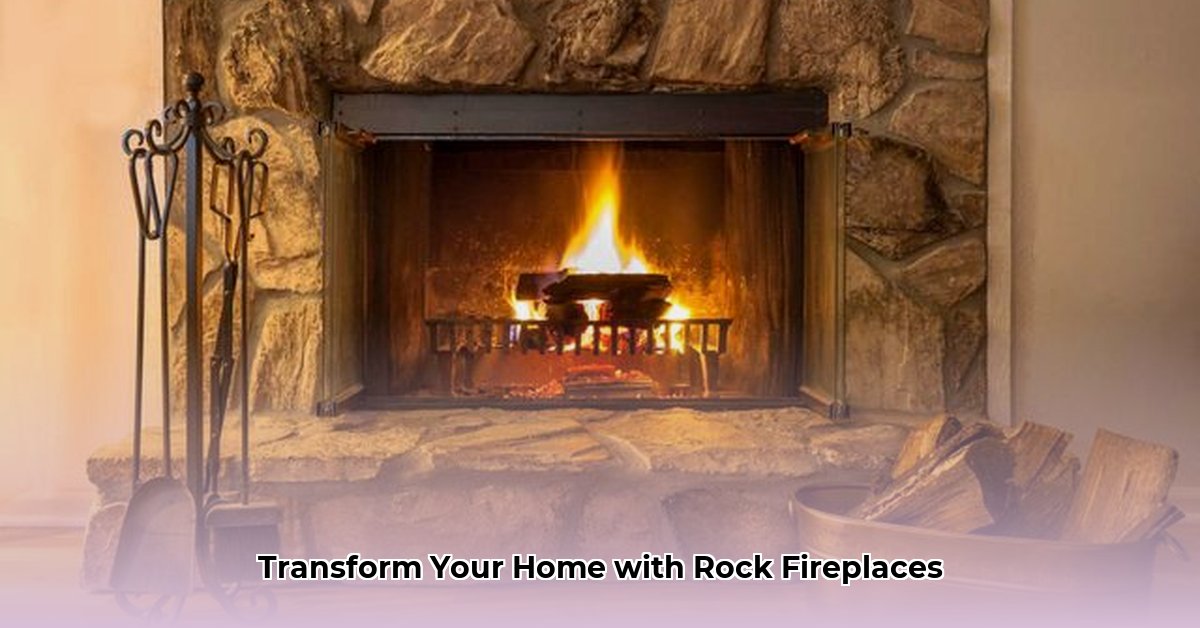Want a fireplace that’s both stunning and cozy? Choosing the right stone is key! This guide will help you select the perfect rock for your fireplace, focusing on its visual appeal, heat resistance, and ease of maintenance. We’ll explore various popular options such as granite, limestone, and slate, ensuring you find one that aligns with your personal style and budget. Whether you’re a seasoned DIY enthusiast or a beginner, this guide provides essential information to make an informed decision, enabling you to enjoy a beautiful and safe fireplace for many years.
Rock Fireplace & Natural Stone Options: Choosing the Perfect Stone for Your Hearth
Planning to build a rock fireplace? Excellent! It’s a wonderful way to enhance the warmth and character of your home. With a plethora of stone options available, selecting the right one can seem daunting. This guide simplifies the selection process, providing you with the knowledge needed to choose the perfect rock for your fireplace. Prepare to transform your living space with the timeless elegance of a rock fireplace!
Types of Rock for Your Fireplace: Granite, Limestone, Slate, and More
Let’s delve into the most favored rock choices for fireplaces, each distinguished by its unique aesthetic, durability, and specific care requirements. Think of it as picking the perfect outfit – each stone presents a different style and distinct characteristics.
Granite: The Enduring Champion of Heat Resistance and Style
- Looks: Granite is undeniably impressive, available in a wide spectrum of colors and patterns, from deep browns and striking blacks to vibrant reds and myriad shades in between. Its versatility ensures it complements various home styles seamlessly. Common finishes include polished, honed, and leathered, each offering a different tactile and visual experience.
- Heat Resistance: Granite excels in handling intense heat from any fireplace type—wood-burning, gas, or electric—with remarkable resilience. Its high thermal mass also means it retains heat well, providing prolonged warmth.
- Durability: Granite is incredibly durable, promising longevity for generations. It demonstrates high resistance to cracking, scratching, and chipping, making it a solid choice for high-use areas.
- Maintenance: Maintaining granite involves simple, periodic sealing to protect against stains and preserve its appearance. Daily cleaning can be done with a mild detergent and water.
- Cost: Granite’s cost typically ranges from moderate to high, but its lasting durability ensures it’s a worthwhile investment for homeowners seeking both beauty and reliability.
Limestone: The Subtle Sophisticate for Elegant and Understated Designs
- Looks: Limestone features softer and lighter hues, creating a serene and elegant ambiance. Ideal for those aiming for a relaxed yet sophisticated aesthetic, limestone offers a natural, matte finish that diffuses light beautifully. Colors range from creams and beiges to light grays and tans, often with subtle fossils or veining that add character.
- Heat Resistance: Limestone is more sensitive to extreme heat, making it better suited for gas or electric fireplaces. Prolonged exposure to high temperatures from wood-burning fires might cause damage or discoloration.
- Durability: Limestone is durable but less robust than granite. It is more prone to wear and tear from acidic substances and heavy impacts. Regular sealing helps mitigate these issues.
- Maintenance: Maintenance includes regular sealing to protect against stains and damage. Gentle cleaning with pH-neutral cleaners will prevent etching and maintain its natural appearance.
- Cost: Limestone is generally more affordable than granite, positioned in the low to moderate price range, making it an accessible option for many homeowners.
Marble: The Luxurious Statement for Unparalleled Elegance
- Looks: Marble epitomizes luxury and elegance, boasting a classic aesthetic with unique veining patterns that add sophistication to any room. Available in various colors, including white, black, green, and pink, marble can be polished to a high gloss or honed for a softer look. Each slab of marble is unique, ensuring a one-of-a-kind installation.
- Heat Resistance: While marble can withstand high temperatures, it is susceptible to thermal shock. Rapid temperature changes can cause it to crack, making it necessary to consider this when selecting it for a fireplace.
- Durability: Despite its beauty, marble requires careful handling. It is prone to scratching and etching from acidic substances. Protective measures are essential to preserve its pristine condition.
- Maintenance: Regular cleaning and sealing are crucial to maintaining marble’s luxurious appearance. Spills should be cleaned immediately to prevent staining, and abrasive cleaners should be avoided.
- Cost: Marble commands a premium price, reflecting its status as a high-end material. The investment, however, yields unmatched elegance and timeless beauty.
Slate: The Rustic Charm with a Unique and Earthy Aesthetic
- Looks: Slate exudes natural, rustic charm with its layered appearance and matte finish, adding character and texture to any space. Its colors range from deep grays and blacks to greens, purples, and browns, often with subtle variations that enhance its natural appeal. Slate is typically cleft, meaning it has a slightly uneven surface that adds to its rustic charm.
- Heat Resistance: Slate offers moderate heat resistance but is less suitable for intense wood-burning fires. Its layered structure can make it prone to cracking under very high temperatures.
- Durability: Slate is relatively durable, though it can still crack under extreme heat or stress. It is resistant to staining and water damage, making it a practical choice for fireplace surrounds.
- Maintenance: Slate is relatively low-maintenance, requiring only occasional cleaning with a mild detergent and water. Sealing can enhance its resistance to staining and moisture.
- Cost: Slate typically falls into the low to moderate price range, offering an affordable option for homeowners seeking a rustic yet durable fireplace material.
Faux Stone: The Budget-Conscious Option for Cost-Effective Fireplace Design
- Looks: Faux stone aims to replicate the appearance of natural stone, providing a more affordable alternative. While it can mimic various stone types, it often lacks the unique character and texture of genuine stone. Available in panels or individual stones, faux stone can be installed more easily than natural stone.
- Heat Resistance: Faux stone is not ideal for high-heat environments and is unsuitable for wood-burning fireplaces. It is best used with electric fireplaces that produce minimal heat.
- Durability: Faux stone offers moderate durability but can degrade over time, particularly with exposure to heat. It is also more susceptible to scratches and impacts compared to natural stone.
- Maintenance: Faux stone is low-maintenance, typically requiring only a simple wipe down to keep it clean. Avoid using abrasive cleaners that can damage the surface.
- Cost: Faux stone is the most budget-friendly option, making it accessible for homeowners looking to achieve the look of stone without the higher cost.
River Rock & Flagstone: Natural Wonders for Distinctive Hearth Designs
- Looks: River rock provides a unique and organic feel with its smooth, rounded stones, while flagstone offers large, flat pieces with varied textures. Both materials bring a touch of nature indoors, creating a distinctive hearth design. River rock fireplaces often evoke a sense of tranquility, while flagstone provides a more structured, architectural appearance.
- Heat Resistance: Heat resistance varies depending on the specific stone type. River rock may be more prone to cracking under high heat, whereas flagstone generally holds up better due to its density and composition.
- Durability: Both river rock and flagstone are moderately durable, though their longevity depends on the type of rock and the quality of the installation. Proper installation is essential to prevent shifting or cracking over time.
- Maintenance: Maintenance ranges from moderate to high. River rock requires more frequent cleaning due to its crevices and texture, while flagstone can be easier to maintain with regular sealing and gentle cleaning.
- Cost: Generally, river rock and flagstone fall into the moderate price range, making them accessible options for homeowners seeking natural and distinctive fireplace designs.
Choosing Your Perfect Rock: A Streamlined Guide & Comparison Chart
This table presents a concise summary of essential characteristics to guide your choice:
| Material | Heat Resistance | Durability | Maintenance | Cost | Best For |
|---|---|---|---|---|---|
| Granite | Excellent | Excellent | Moderate | Moderate-High | All Fireplace Types |
| Limestone | Moderate | Moderate | Moderate | Low-Moderate | Gas & Electric Fireplaces |
| Marble | High (Thermal Shock Sensitive) | Moderate | High | High | Gas & Electric Fireplaces |
| Slate | Moderate | Moderate | Low | Low-Moderate | Gas & Electric Fireplaces |
| Faux Stone | Low | Moderate | Low | Low | Electric Fireplaces Only |
| River Rock | Variable | Moderate | High | Moderate | Electric & Gas (With Caution) |
| Flagstone | High | High | Moderate | Moderate | All Fireplace Types |
Decision-Making Flowchart:
- Establish Your Budget: High budget? Prioritize granite or marble. Low budget? Consider limestone, slate, or faux stone.
- Determine Fireplace Type: Wood-burning? Opt for granite or flagstone. Gas or electric? A wider array of choices is available.
- Define Desired Aesthetic: Modern? Marble may be ideal. Rustic? Slate is perfect. Traditional? Granite likely fits
- Gray Kitchen Backsplash Tile: Ideas for a Stylish Upgrade - December 14, 2025
- Backsplash For Gray Cabinets: Choosing the Right Backsplash Style - December 13, 2025
- Gray And White Backsplash: Ideas For Timeless Style - December 12, 2025









